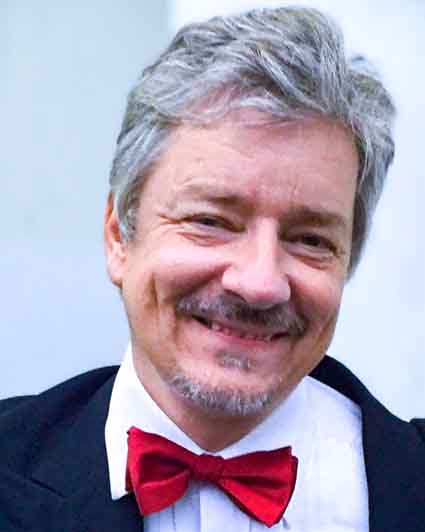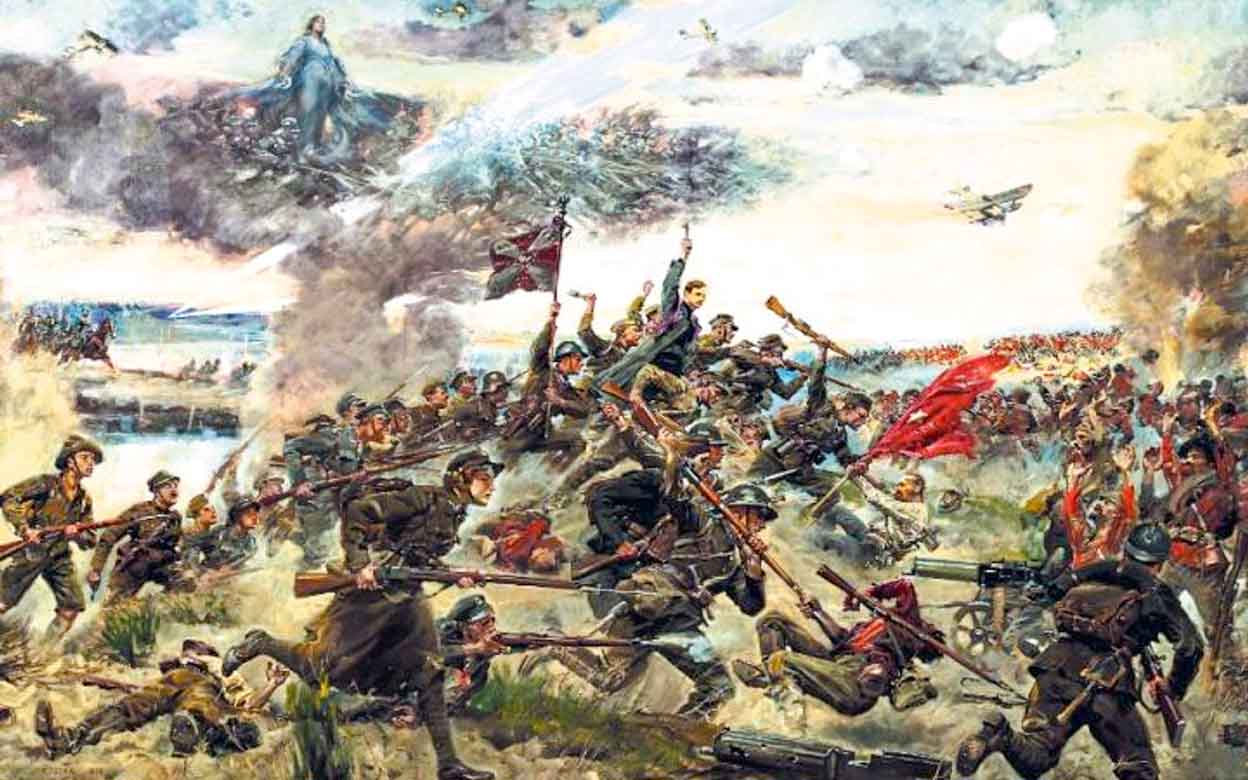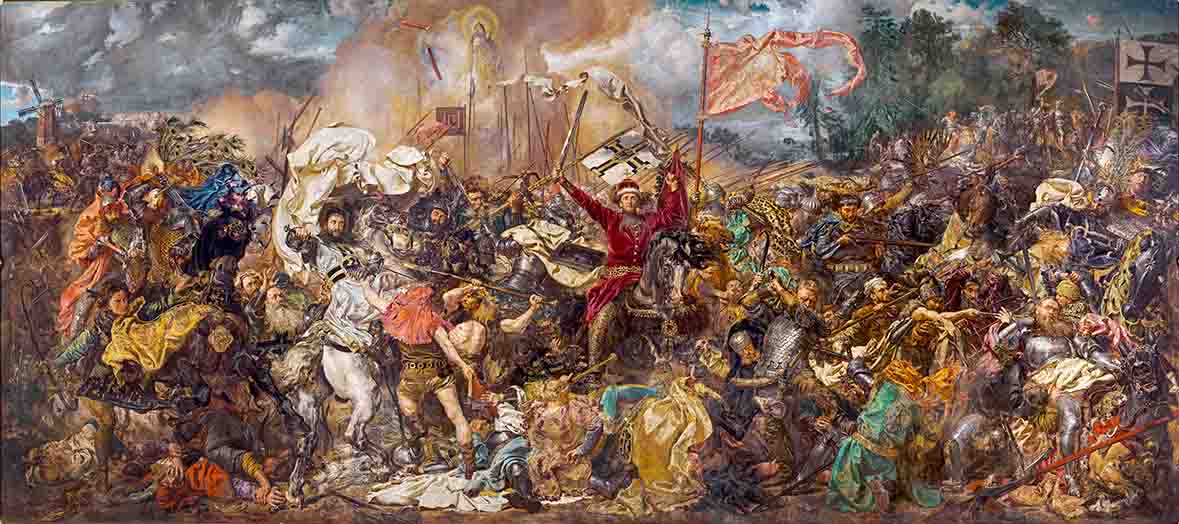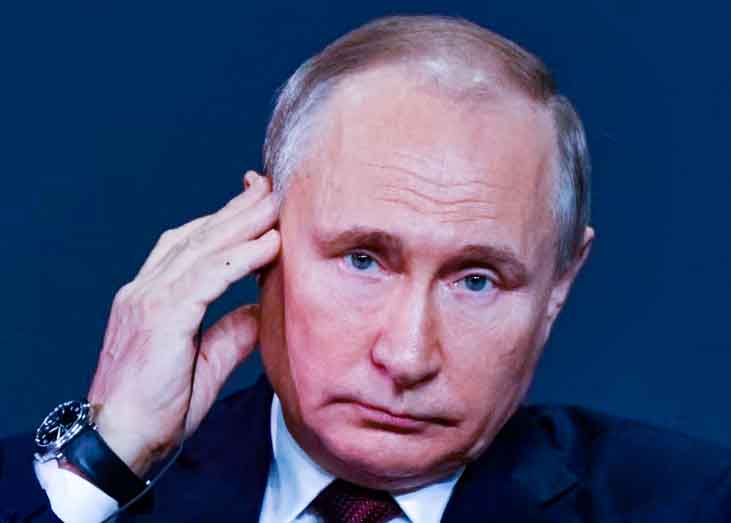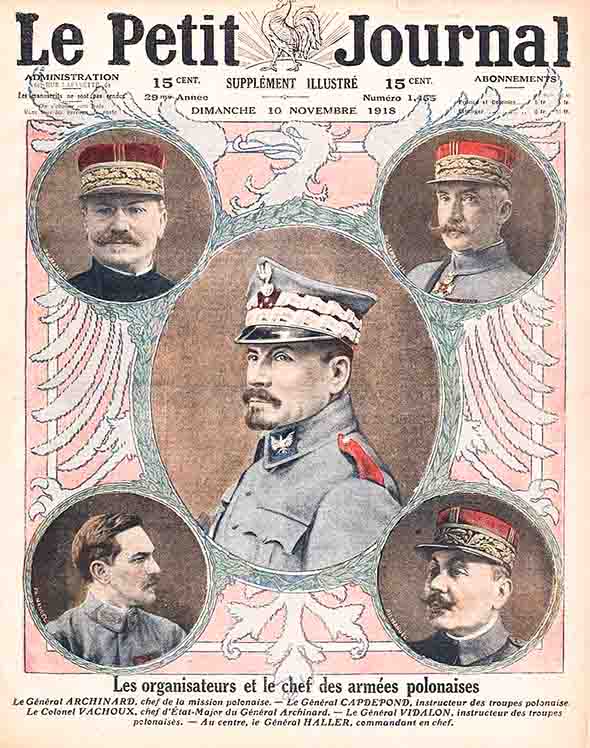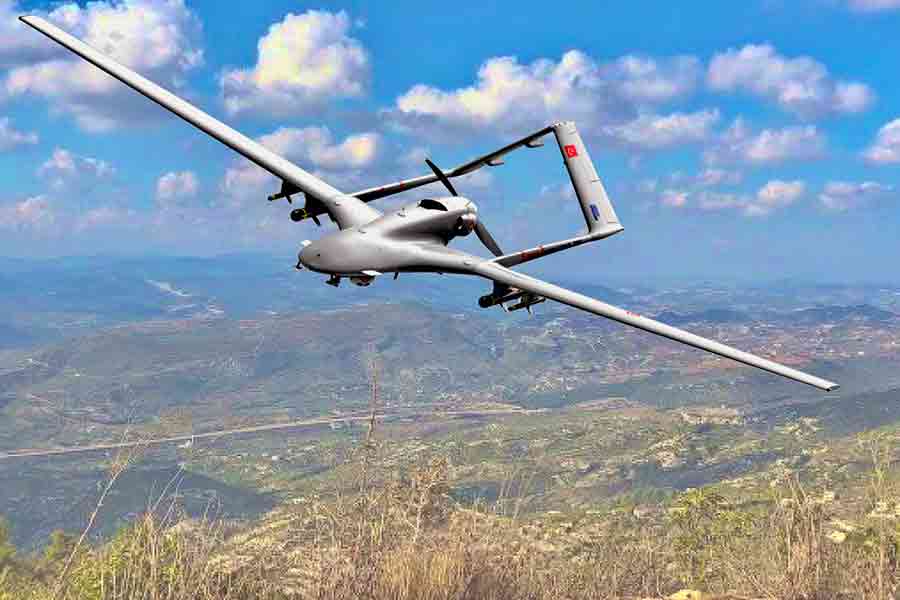The Polish Army Day is celebrated since 1992 in memory of the Battle of Warsaw in 1920, also known as the "Miracle on the Vistula River" (Cud nad Wisłą), fought during the Polish-Bolshevik war, when Polish troops defeated the Russians, stopping their expansion to the west.
The Russian Bolsheviks thus suffered a humiliating defeat — the only decisive military defeat in the history of the Soviet Union. The victory over the Red Army also allowed the young, recently re-established Polish state to maintain the independence obtained in 1918 and it also may have prevented a Bolshevik invasion of Germany and blood-thirsty Lenin revolution's further progress into Western Europe.
British politician and diplomat Edgar Vincent, observing first-hand, considered it one of the most important battles in all human history, because the Polish victory over the Soviets stopped the spread of communism further west to Europe. [5]
The defeat crippled the Red Army. Estimated Russian losses were 10,000 killed, 500 missing, 30,000 wounded, and 66,000 taken prisoner, compared with Polish losses of some 4,500 killed, 10,000 missing, and 22,000 wounded. Poland captured about 231 pieces of artillery and 1,023 machine guns. Vladimir Lenin, the Bolshevik leader, called it "an enormous defeat" for his forces. [5]
August 15 was chosen because, on that day in 1920, in the night hours, the first units of the 21st Mountain Division began crossing the Wieprz river near Kock and — separately — the town of Radzymin was liberated. In this way, a successful counteroffensive began, as a result of which the troops of the Russian Western Front under the command of Mikhail Tukhachevsky were crushed.
Soldier's Day
August 15 was initially celebrated as the Soldier's Day during the Second Polish Republic (until 1939), sanctioned by the order of the Minister of Military Affairs, General Stanisław Szeptycki (No. 126 of August 4, 1923).
In the days of the communist People's Republic of Poland, the Polish Army Day was established instead on October 12 annually to commemorate the then-symbolic — and, as it since emerged, very controversial, because it turned out to be more of a failure than a victory — Battle of Lenino.
It was only after the fall of communism that the Sejm of the Republic of Poland officially established August 15 as the Polish Army Day in 1992. It is a statutory day off from work, as it coincides with the Church's feast of the Assumption of the Mother of God.

Honor Guard Regiment of the Polish Armed Forces on a parade in Warsaw (Source: Wikipedia)
Official ceremonies take place in the capital in front of the Tomb of the Unknown Soldier, where an honorary change of guard is performed. For several years, a great military parade has also been organized on the streets of Warsaw with the participation of many soldiers and heavy combat equipment. The president, as the Commander-in-Chief of the Polish Armed Forces, also participates in the march.
As is customary every year, also this year, a ceremonial change of guard was held in front of the Tomb of the Unknown Soldier at Piłsudski Square in Warsaw. It was attended by the President of the Republic of Poland, the Chief of the Armed Forces Andrzej Duda with his wife, the members of the Chancellery of the President of the Republic of Poland, representatives of state authorities, soldiers and veterans. [1]
Today it is our responsibility to spare no efforts and resources to provide the best and the most modern equipment for the Polish army. So that we would not only be able to defend ourselves, but also that we would not have to defend ourselves
said the president.
Radzymin — Small Town, Great History
The Battle of Radzymin, fought between August 13 and 18, 1920, was an important part of the struggle against the Russian invasion. It was a key part of what later became known as the Battle of Warsaw. It also proved to be one of the bloodiest and most intense battles of the Polish–Soviet War.
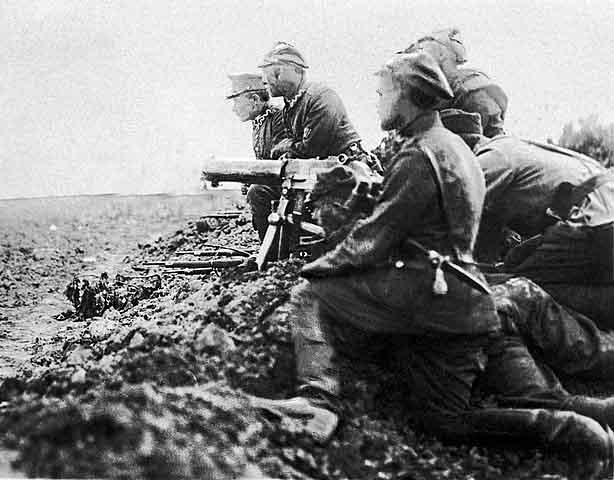
Polish machine gunners at Radzymin, 1920 (Source: Wikipedia)
Radzymin is a small town in the Mazowieckie Voivodeship, in the Wołomin County, located about 10 km from Wołomin itself and about 25 km north-east from the center of Warsaw. In 2016, it had a population of just over 12,000, but it has a long history. It obtained city rights in 1475. It is one of the oldest cities in Mazovia, as its settlement dates back to the 13th century. As the locals say, it is "a small town, but with a great history". Although some people claim that the name of the original settlement stems from the Polish radzę omiń ("you are advised to pass by"). [6] The Bolsheviks should have listened to this advice.
Radzymin is most famous for the fact that the decisive battles of the Battle of Warsaw with the advancing Bolshevik troops took place in its vicinity. The town changed hands multiple times over the course of the few days in August 1920. The town itself was completely destroyed as a result.
Radzymin was recaptured on August 15 by the units of the Polish 5th Army under general Joseph Haller and this victory proved to be one of the turning points of the battle of Warsaw. The strategic counteroffensive was successful, pushing Soviet forces away from Radzymin and Warsaw and eventually crippling four Soviet armies.
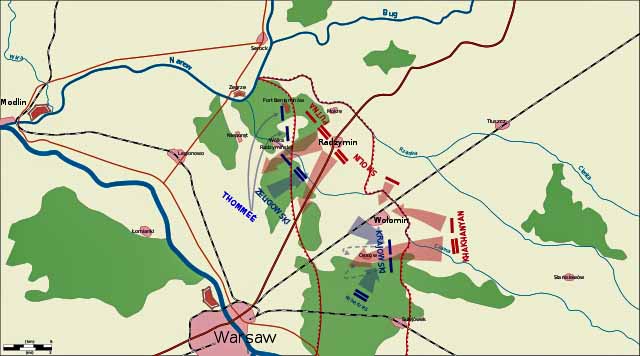
Battle of Radzymin, August 1920. (Source: Wikipedia)
The battle was undoubtedly a success for the Poles at both the tactical level (the battle of Radzymin itself) and the strategic level (its role in the battle of Warsaw). After several days of constant fighting for the town of Radzymin and its immediate vicinity, the Russian attack was repelled and the Poles were able to mount a successful counteroffensive, forcing the Russian armies out of Poland and, in the end, destroying them completely. [2]
However, the conduct of the Polish forces and their commanders at Radzymin in the early part of the battle has been criticized by historians almost since the moment the guns stopped firing in 1920. Some military analysts suggest that the importance of the northern approach to Warsaw was poorly understood by the Polish commanders prior to the battle and that the task of defending Radzymin was marred by "sheer incompetence". [2]
Some authors argued that on August 13, when the first Russian forces appeared around Radzymin, there was more than enough time and resources to reinforce the weak Polish forces there, rather than taking several days to recapture what should have been held from the start. So it could be concluded that the enormous sacrifice and losses by the Polish Amy in the Battle of Radzymin was — at least partly — of its own doing.
The term "Miracle on the Vistula River" itself, originally coined by Sejm deputy Stanisław Stroński, a Marshal Piłsudski opponent, may be underestimating the contribution of the brilliant military leadership by Jóżef Piłsudski, Józef Haller, and other Polish officers, the heroic efforts of the Polish soldiers, and — first and foremost — the fact that Polish cryptologists broke Russian ciphers they had intercepted as early as September 1919, giving the Polish military commanders unique insight into the intentions and movements of the Russian forces.
The Polish Army Today
The Armed Forces of the Republic of Poland (Siły Zbrojne Rzeczypospolitej Polskiej, abbreviated SZ RP; popularly called Wojsko Polskie in Poland, abbreviated WP — roughly, the "Polish Military") are the national armed forces of the Republic of Poland. [2]
Since 2009, compulsory conscription to the army is no longer obligatory, the army has become professionalized.
Poland is an active member of NATO since March 12, 1999, and the Polish military currently numbers about 130,000 soldiers. Its structures have gradually been and continue to be modernized.
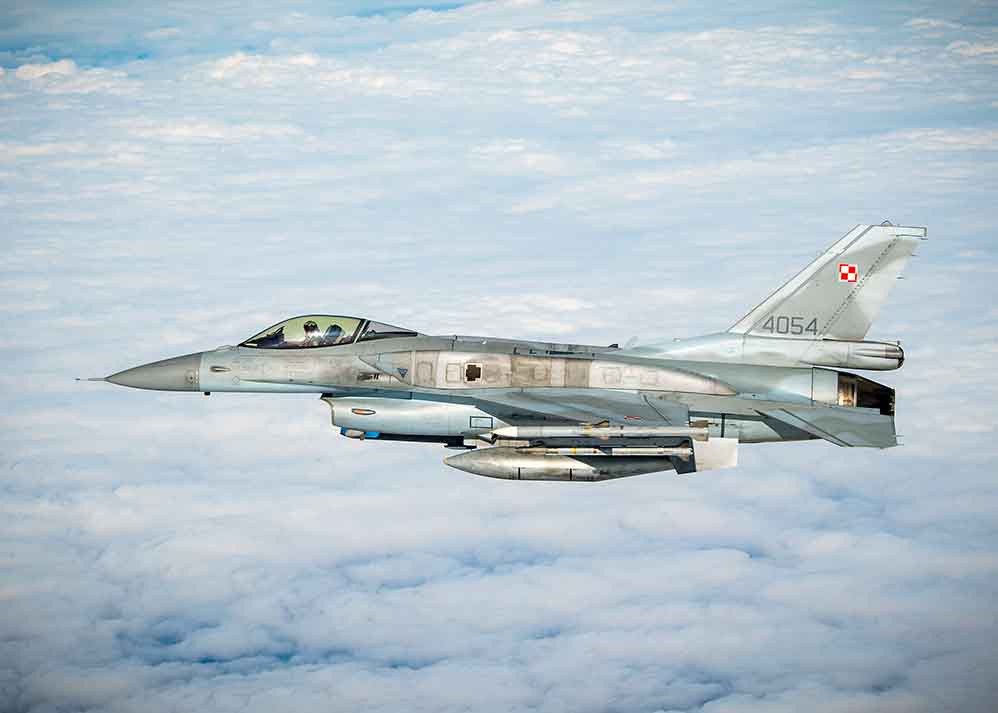
A Polish F-16 (Source: Wikipedia)
Prompted in part by this year's Russian invasion of Ukraine, the Polish government announced plans in March 2022 to more than double the size of the armed forces to 300,000 personnel, and to spend at least 3% of GDP on defense. It is worth noting that Poland, unlike many of its much more economically developed allies, has consistently been spending around 2% of its GDP on defense, in line with its obligations under NATO.
The Polish Armed Forces are the only military entity in the world to use a two-finger salute which is only used while wearing a hat, such as military hat rogatywka with the emblem of the Polish eagle. It refers to the fact that the salute is given to the emblem itself. The salute is performed with the middle and index fingers extended and touching each other, while the ring and little fingers are bent and touched by the thumb. The tips of the middle and index fingers touch the peak of the cap, two fingers meaning "Honour and Fatherland" (Honor i Ojczyzna). [2] [7]
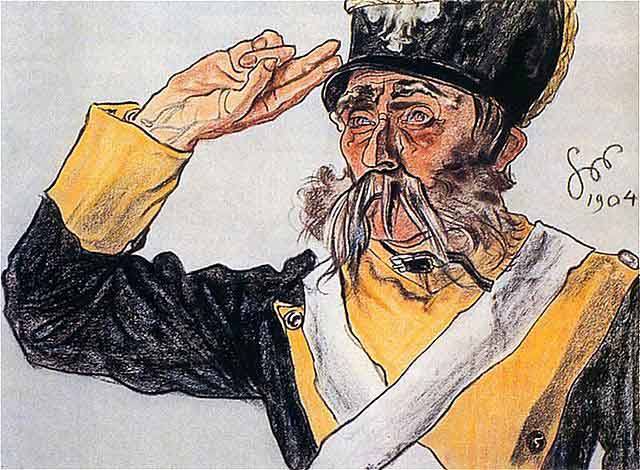
A two-fingers salute. Drawing by Stanisław Wyspiański, 1904. (Source: Wikipedia)
On this Polish Army Day, in the tumultuous year 2022 we, as Kuryer Polski, would like to extend our sincerest "thank you" to all members of the Polish military, those currently serving, and also those who used to serve in the past "For Our Freedom and Yours."



